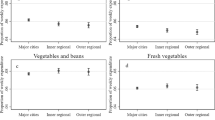Abstract
Objective: To identify if the nutritional status and improvements in Vietnam during the 1990s applied equally to the key vulnerable population groups (poor, rural, and ethnic minority) as it did to the nonpoor—largely in the urban areas.
Design: This study used cross-sectional analyses in the context of inequalities occurring in the diets of the poor and nonpoor that accompanied economic improvements during the Vietnam Doi Moi period.
Setting: During the Doi Moi period in Vietnam.
Subjects: A cross-sectional analysis was conducted on data using 23 839 individuals (4800 households) from the Vietnam Living Standard Survey (VLSS) in 1992–1993 and 28 509 individuals (6002 households) from the Vietnam Living Standard Survey in 1997–1998. Analysis for changes in food consumption was conducted on 17 763 individuals (4305 households) that were included in both surveys.
Interventions: None.
Results: After initiation of Doi Moi in 1986, the average Vietnamese person reached the dietary adequacy of 2100 kcal per day per capita in the early 1990s, but this did not improve during the next decade. The structure of diet shifted to less starchy staples while proteins and lipids (meat, fish, other protein-rich higher fat foods) increased significantly. Although the gap in nutrient intake between the poor and the nonpoor decreased, the proportion of calories from protein- and lipid-rich food for the poor is lower than for the nonpoor. The VLSS data showed that the increase of protein and lipid foods in total energy structure over the 5 y between the VLSS studies for poor households was 0.43% (CI=0.33, 0.53) and 0.47% (CI=0.41, 0.54) lower, respectively, than for nonpoor households (P<0.0001). Inequalities compared to the nonpoor were also found in both quantity and quality of food consumption. For example, poor households consumed (quantity) 127 kcal/day (CI=119, 135) less from meat, and 32 kcal/day (CI=27, 38) less from fats than nonpoor households (P<0.0001), and the proportion of calories consumed (quality) by poor households was 5.8% (CI=5.4, 6.1) less from meat and 0.96% (CI=1.2, 0.7) less from fats than by nonpoor households (P<0.0001).
Conclusions: Although the key vulnerable groups—rural, poor, and minority populations—showed improvements in diet, there still remains an inequity between these groups and the nonpoor of the population. In particular, the vulnerable groups consumed less of their daily consumption from the desirable high-quality proteins of animal foods and fats, and more from cereals and other starches—lagging the better-off populations in desired composition.
Sponsorship: Carolina Population Center, University of North Carolina at Chapel Hill, NC, USA.
This is a preview of subscription content, access via your institution
Access options
Subscribe to this journal
Receive 12 print issues and online access
$259.00 per year
only $21.58 per issue
Buy this article
- Purchase on Springer Link
- Instant access to full article PDF
Prices may be subject to local taxes which are calculated during checkout
Similar content being viewed by others
References
Bhushan I, Bloom E, Nguyen MT & Nguyen HH (2001): Human Capital for the Poor in Vietnam. Manila: Asian Development Bank.
Dasgupta P . (1993): An Inquiry into Well-Being and Destitution. Oxford: Oxford University Press.
Doan VD (1995): Food production in Vietnam. University of Agriculture and Forestry, Ho Chi Minh City, Vietnam, 1995-12-01. Online, available from: http://www.agnet.org/library/article/ [accessed October, 2002].
Food and Agriculture Organization of the United Nations, Vietnam Office. (FAO–VN) (1999): ENS–Nutrition Country Profile, Vietnam, 1999.
General Statistical Office (1994): Vietnam Living Standards Survey, 1992–1993. Hanoi: Statistical Publishing House.
General Statistical Office. (2000): Vietnam Living Standards Survey, 1997–1998. Hanoi: Statistical Publishing House.
General Statistical Office (2001): Vietnam 1975–2000. Hanoi: Statistical Publishing House.
Glewwe P, Koch S & Nguyen BL (2001): Child nutrition, economic growth, and the provision of health care services in Vietnam in the 1990s. Unpublished paper.
Hunt J & Quibia MG (2001): Nutrition and Development Series No. 1: Investing in Child Nutrition in Asia, p 13. Manila: Asian Development Bank.
National Institute of Nutrition (2001): Twenty Years of Prevention and Control of Micronutrients Deficiencies in Vietnam: Research and Development 1980–2000. Hanoi: Medical Publishing House.
Ogle BM, Hung PH & Tuyet HT (2001): Significance of wild vegetables in micronutrients intakes of women in vietnam: an analysis of food variety. Asia Pac J. Clin. Nutr. 10(3), 249.
Stata Press (2001): Intercooled Stata, Version 7 release. College Station, TX.
Strauss J & Thomas D (1998): Health, nutrition, and economic development. J. Econ. Literature 36, 766–817.
Thang NM & Popkin BM (2003): In an era of economic growth, is inequity holding back reductions in child malnutrition in Vietnam? Asia Pac J. Clin. Nutr., in press.
Tuyen LD & Brica N (2002): Trends in food consumption and main the nutritional status in urban Vietnam. Online, available from: http://www.fao.org/ag/ags/agsm/sada/asia/DOCS/DOC/Ledanh1.doc [accessed June 2002].
United Nations Development Programme (UNDP) (2000): Human Development Report. New York: UNDP.
World Bank (1999): Vietnam: Attacking Poverty. Washington, DC: World Bank.
Author information
Authors and Affiliations
Corresponding author
Rights and permissions
About this article
Cite this article
Thang, N., Popkin, B. Patterns of food consumption in Vietnam: effects on socioeconomic groups during an era of economic growth. Eur J Clin Nutr 58, 145–153 (2004). https://doi.org/10.1038/sj.ejcn.1601761
Received:
Revised:
Accepted:
Published:
Issue Date:
DOI: https://doi.org/10.1038/sj.ejcn.1601761
Keywords
This article is cited by
-
Association of meat consumption with the risk of gastrointestinal cancers: a systematic review and meta-analysis
BMC Cancer (2023)
-
Moderate and transient impact of antibiotic use on the gut microbiota in a rural Vietnamese cohort
Scientific Reports (2022)
-
Food security and food quality among vanilla farmers in Madagascar: the role of contract farming and livestock keeping
Food Security (2021)
-
Socioeconomic inequality in cardio-metabolic risk factors in a nationally representative sample of Iranian adolescents using an Oaxaca-Blinder decomposition method: the CASPIAN-III study
Journal of Diabetes & Metabolic Disorders (2019)
-
Shifting configurations of shopping practices and food safety dynamics in Hanoi, Vietnam: a historical analysis
Agriculture and Human Values (2016)


